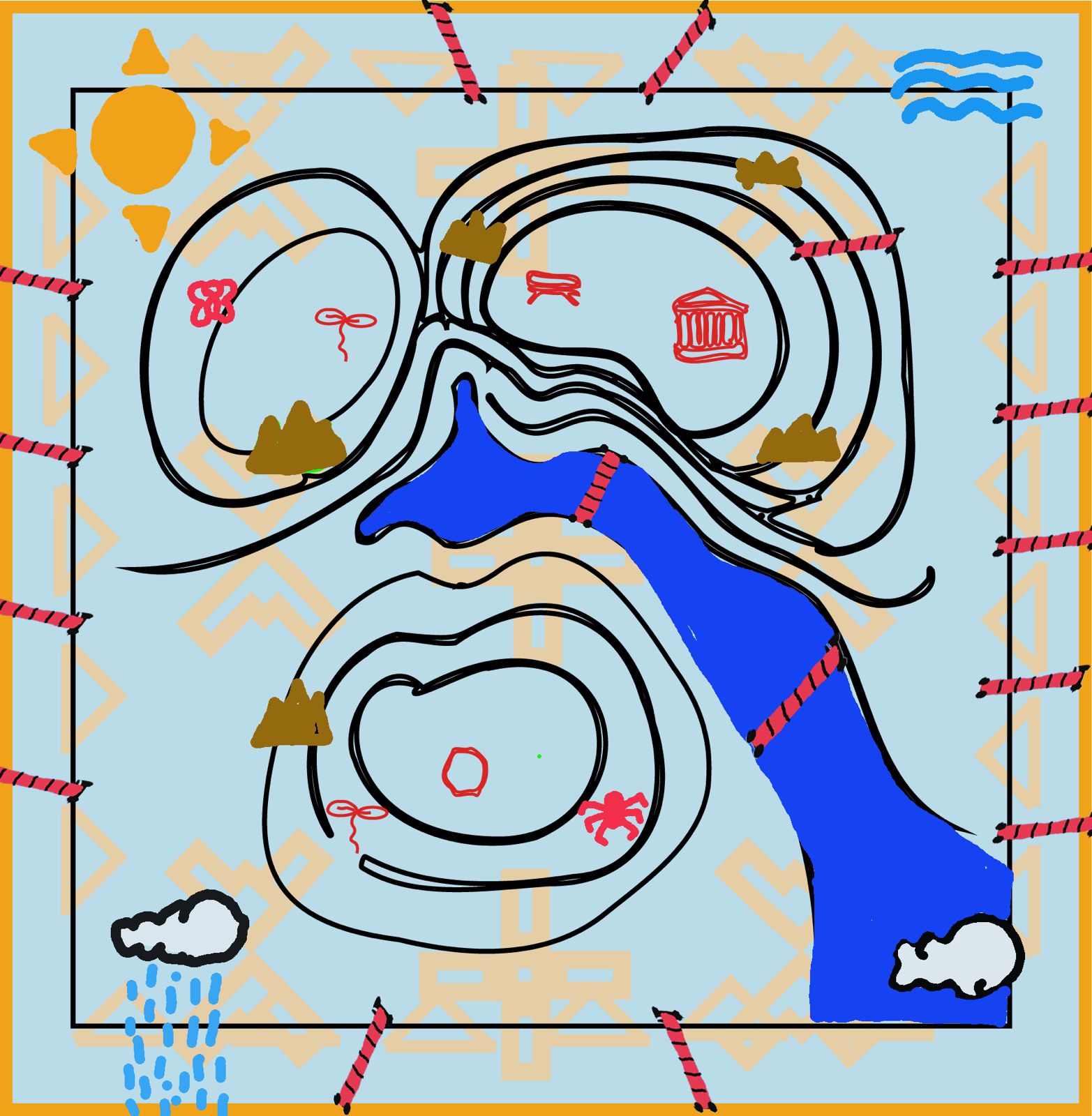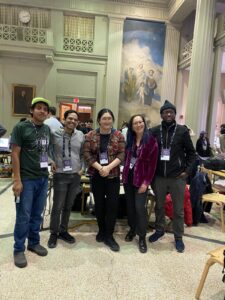
Design by Jesus Morales
[ID: Digital painting of a map for Delta Real/ation. The multicolor graphic shows different environments such as mountains, bodies of water, buildings, and more.]
In January, I attended the MIT Reality Hack, an Extended Reality (XR) hackathon in Cambridge, Massachusetts as part of my professional development tour. XR is an umbrella term that includes augmented reality (AR), virtual reality (VR) mixed reality (MR), and anything in between. The MIT Reality Hack motto, “Hack to the Future”, unfolds annually as a community-driven XR hackathon, attracting a diverse ensemble of XR professionals, brand mentors, creators, participants, students, and tech enthusiasts. There are also a LOT of prizes! This gathering serves as a nexus where attendees engage in tech workshops, discussions, project collaborations, and innovative endeavors.
But what exactly is hacking? It’s the art of coaxing hardware into performing beyond its prescribed functions, a technicity articulated by phenomenology philosopher Erin Manning. In her book Always More Than One, she draws parallels between dance-making, specifically William Forsythe’s choreography, and improvisation emphasizing the importance of pushing the boundaries of technical vocabulary to spark new creations, a technicity or a hacking, underscoring how choreographers and dance artists engage in the manipulation of language and gestures of movement to cultivate invention.[1]
The best part of this event is the wide range of backgrounds and skill levels of attendees from all over the world. Although the event requires an application process and community agreements with check-ins, I had the opportunity to meet people from the XR industry, academics, and people who simply love to play, fail, and play again. My collaborators NI DO TO XR — an exhibit on the choreographic research for IKKAI featuring interactive technologies such as an Obon dance tutorial hologram and a video game of packing and unpacking — encouraged me to apply. Being the kind of dancer used to being well rehearsed, or at least thoroughly planned, I wasn’t sure how I could go to the hackathon if I didn’t already have a plan or idea in motion. How would I fit in? What would I even do? But then I considered that maybe that was the point. What I discovered is that as dance artists, we are natural storytellers who integrate physical interactivity with design, and these skills are essential in XR.
After an intensive day of workshops ranging from sound haptic design to ethical hacking, I found myself at 11 pm in an impressive and modern MIT campus building on a multigenerational team working on a project with Ayaskant Panigrahi, Jennifer Chan, Barak Hussein, and Jesus Morales. Collectively, we embodied the intersection of programming, design, cyber security, and, of course, dance. A team of diasporic XR creatives — developers, designers, and dreamers.

[ID: Delta Real/ation team smiles and poses in a busy classic building with many tables behind them. This multigenerational team of diverse ethnicities looks pleased with their work.]
Our project Delta Real/ation introduced a game where migrants lead in designing their new settlements rooted in a mixed reality XR game. This project followed a more-than-human design ethos, placing players in the shoes of Koda and Nisa, recent migrants tasked with planning a sustainable and inclusive community. Aligned with the UN Sustainability Goal #11, the game aims to foster inclusive, safe, resilient, and sustainable cities and human settlements. The Looking Glass, a 3D frame-like display, serves as a window into Koda’s Meta Quest or VR headset design process, making transparent what is usually invisible: individual decision-making and its potential community consequences. After a round, players swap roles and are then encouraged to contemplate gestures of welcome for newcomers in their communities. This project drew inspiration from speculative design principles, embracing the Protopia Futures framework to explore possible, plausible, probable, and preferable futures. Through ideation processes, world-building, and collaborative activities, Delta Real/ation envisioned a future where diverse communities can thrive. If you are interested, check out our game building on our DevPost.
Back in San Francisco, and being home, I’ve begun to integrate my three-week professional development tour. One of the things that has become clear is a larger research question guiding my work inspired by a conversation I was having with the co-interrogators of Dancing Around Race, Gerald Casel, David Herrera, Raissa Simpson, and Bhumi Patel: how might creative practice be employed as a framework for harm reduction within the capitalist context in which we live? Through creative practice, I can actively involve and evolve, implicate myself, and invite my audiences to journey alongside me.
One of the next pieces I am working on to premier in 2026 is (a) Bathing, a fantastical, immersive dance film where viewers’ bodies control a visual narrative that flickers between staid urban gardens and the natural glory of a forest or natural environment. This is to stimulate audiences into imagining a diverse community where colonial modernity converses with these majestic lands. I will use a motion-tracking camera on the audience so viewers explore how group movement affects the narrative outcomes of this film. If little or no movement is detected, the film glitches to an alterity of a city or suburban garden, dancing a metaphor of neo-colonialism. (a) Bathing contemplates in motion the historical tensions between migration, settlement, belonging, and being responsible to a beloved place – nature. When the audience moves together at a certain speed, a metaphor for collective action, they will witness an emerging screen story that reflects the interior lives of the film’s all-BIPOC cast. This culturally rich community comes from a range of socio-historical positions, yet bathing in nature together will show a poetic relationality that contests the present world’s racial and colonial hierarchies of value. With the audience experiencing collective physical movement, I hope this embodied social art experience with integrated technology will help foster and imagine a cross-racial alliance for audiences to reckon with their conscious and unconscious colonial complicity.
[1] Manning, Erin. 2012. Always More than One. Duke University Press EBooks. https://doi.org/10.1215/9780822395829.
This article appeared in the Spring 2024 issue of In Dance.


